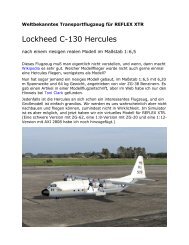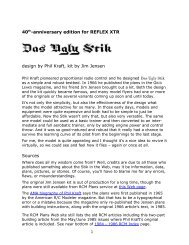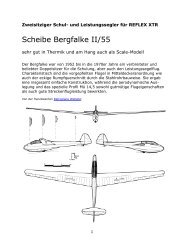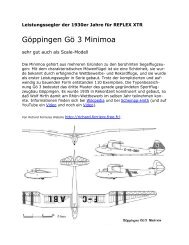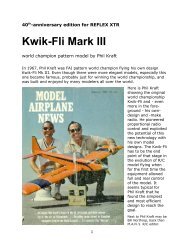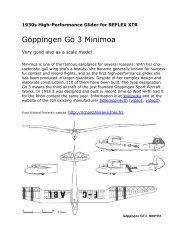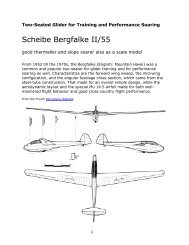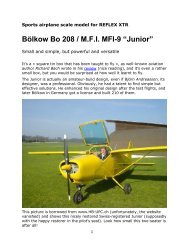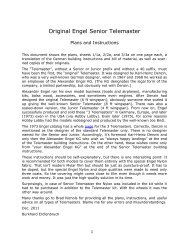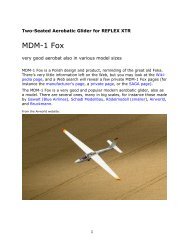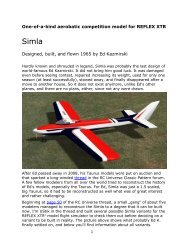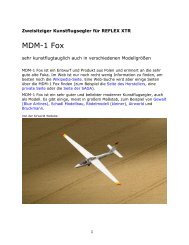CHK Thermik-Star spezial
CHK Thermik-Star spezial
CHK Thermik-Star spezial
Erfolgreiche ePaper selbst erstellen
Machen Sie aus Ihren PDF Publikationen ein blätterbares Flipbook mit unserer einzigartigen Google optimierten e-Paper Software.
<strong>Thermik</strong>segler mit 2,57 m Spannweite für REFLEX XTR<strong>CHK</strong> <strong>Thermik</strong>-<strong>Star</strong> <strong>spezial</strong>mit und ohne elektrischen AntriebDer <strong>Thermik</strong>-<strong>Star</strong> ist ein sehr schöner <strong>Thermik</strong>-Segler (Softliner) von derkleinen, aber feinen Firma <strong>CHK</strong> in Regensburg. Er war praktisch das Einsteigermodellder Firma, auch für Anfänger geeignet, aber ein vollwertiger Floater.Es gab ihn mit oder ohne Elektroantrieb, mit V- oder T-Leitwerk und mitden großen Flügeln (2,57 m Spannweite) oder etwas kleineren. Auch Bremsklappengab es auf Wunsch. Leider wird das Modell nicht mehr produziert.Hier ist das Modell mit einem 'mittelstarken' Elektroantrieb, V-Leitwerk, großenFlügeln mit Querrudern, aber ohne Bremsklappen abgebildet. Zusätzlichgibt es das gleiche mit leichteren Akkus und auch ganz ohne Antrieb, also alsreinen Segler. Das Flugverhalten ist sehr angenehm und gutmütig, die <strong>Thermik</strong>leistungist sehr gut. Das kann man alles im REFLEX nachvollziehen.1
<strong>Thermik</strong>segler mit 2,57 m Spannweite für REFLEX XTR<strong>Thermik</strong>-<strong>Star</strong>Das Diagramm zeigt die nachgerechnete Geschwindigkeitspolare für dasGleiten. Waagerecht ist die Vorwärtsgeschwindigkeit aufgetragen, senkrechtdie Sinkgeschwindigkeit, beides in m/s. Rechnerisch müßte der <strong>Thermik</strong>-<strong>Star</strong>ein geringstes Sinken von 0,38 m/s bei 8,3 m/s haben und ein flachstesSinken von 0,43 m/s bei 10,0 m/s. Das bedeutet eine beste Gleitzahl von23,2 und ist ganz ordentlich für ein solches Modell (und für das Gewicht von1,7 kg). Gemessen sind die Werte nicht, aber das Modell im REFLEX machtschon den Eindruck, daß es so gut ist.Schon ab einer Einstellung von 1 m/s thermischen Aufwinden geht dasModell ab, und man bekommt es kaum gegen <strong>Thermik</strong> an den Boden. GuteMethoden sind langsam machen (Nase hoch, das Modell kippt nicht seitlichab) und Slippen (Ruderwirkung reicht aus). Manchmal braucht das ModellSeitenruder zu den Querrudern, obwohl diese schon differenziert sind. BeiComputersendern kann man zu vollem Querruder auch 70% Seitenruder amKombi-Mischer einstellen. Das Kurvenverhalten an sich ist stabil und fastneutral.Im REFLEX schlagen die Querruder auch sichtbar als Klappen (Flaperon) aus,und zwar nach unten und nach oben. Hier sind maximal 30° Ausschlag eingestellt,um Bremsklappen wie am richtigen Modell zu haben. Ein Ausschlagnach oben hat aber in REFLEX keine Wirkung, so daß man statt dessen dieQuerruder nach unten ausschlagen muß. Die Steuerbarkeit ist dann beeinträchtigtund man muß mit dem Seitenruder steuern. Seit der Version 5.05von REFLEX kann man die Ruder einzelnen Senderkanälen zuordnen. Dannfunktioniert alles vorbildgerecht (siehe weiter unten).2
7 if (o==null8 #ifdef SYNC9 || txn==null10 #endif11 )12 return;expansion7 #ifdef SYNC8 if (o==null || txn==null)9 return;10 #else11 if (o==null)12 return;13 #endifFigure 3. Transformation of an undisciplined annotation into adisciplined oneas increased maintenance effort or error propagation [2, 20]. By usingundisciplined annotations, differences in code fragments can befactored out at a fine grain. However, reducing the amount of codereplication comes at the price of introducing undisciplined annotations,which are considered to be more difficult to understand. Forinstance, preprocessor annotations obfuscate the source code andmake it difficult to differentiate and locate source code [11, 22].Beside the influence on program comprehension, an undisciplineduse of the preprocessor has further implications. For instance,analysis tools (e.g., data-flow analysis) or transformationtools (e.g., source-code refactoring) require a structural representationof the code in form of an abstract syntax tree. With undisciplinedannotations, such a representation is difficult to create,because fine-grained annotations, such as an annotated openingbracket, cannot be represented in terms of the abstract syntax of thehost language. The reason is that single tokens, such as an openingbracket, may not have counterparts in the abstract syntax tree. Asa consequence, many current IDEs struggle with software projectsthat make use of preprocessors. Typically, in such IDEs, the preprocessorannotations are removed, which causes a loss of variabilityinformation. To shed light on the preprocessor discipline, in previouswork we analyzed the usage of disciplined and undisciplinedpreprocessor annotations in 40 software projects from different domainsand sizes [27]. Except for one small project, we found undisciplinedannotations in all projects. In summary, undisciplined annotationssum up to 16 % of all annotations.Although the major part of preprocessor usage is disciplined,undisciplined annotations are still frequently used, despite theirdisadvantages. This raises the question of whether programmersperform differently using undisciplined or disciplined annotations.More precisely, are there differences in program comprehension forcommon programming tasks, such as maintenance, with respect tothe discipline of annotations? To answer this question, we designeda controlled experiment. Next, we give a detailed description of theexperiment and the material we used.3. ExperimentBy means of an experiment, we evaluate whether the kind of annotation(disciplined vs. undisciplined) has an influence on programcomprehension. To this end, we let subjects solve programmingtasks on several open-source systems and analyzed the correctnessand response time. According to the work of Dunsmoreet al., these tasks can be categorized as maintenance and mentalsimulationtasks, both requiring program comprehension [5]. Next,we give a detailed description of our experimental setting, whereaswe present and discuss the result in Section 4. Both sections arestructured according to the guidelines of Jedlitschka et al. [19].3.1 ObjectivesThe main objective of our experiment is to evaluate whether thediscipline of preprocessor annotations has an influence on programcomprehension. There is an ongoing debate about the disciplineof preprocessor annotation, and the result is yet open. Some peopleargue in favor of disciplined annotations, because they easeautomated analysis and thus tool support for the respective programs[6, 15]. Other people, in turn, prefer undisciplined annotations,because they provide flexibility, expressiveness, and avoidbloated code. As a matter of fact, undisciplined annotations arecommonly used by professional developers [27]. Some developersargue that they have no problem with understanding their owncode that contains undisciplined annotations. 4 While this may bereasonable for small, one-man software systems, it may become aproblem in large systems, in which several developers are involved.Due to these opposing positions regarding the discipline ofannotations, we do not state a hypothesis in favor for a particularkind of discipline, but rather we formulate two research questions,which reflect the essence of the four open questions, which weposed in Section 1:RQ.1 Does the discipline of annotations influence the correctnessof program-comprehension and maintenance tasks?RQ.2 Does the discipline of annotations influence the time neededto solve program-comprehension tasks?Based on these research questions, we define two dependentvariables: response time and correctness. To ensure, that thesevariables are not influenced or biased by other factors, we also haveto control potential confounding parameters [33]. In Table 3.1 weshow the five parameters we found to be most important to controlfor our experiment, together with the control technique we used tocontrol them and the corresponding measurement.Table 1. Confounding parameters, how we controlled them andwhich measurement we usedConf. parameter Control technique MeasurementMotivation Analyzed afterwards QuestionnaireDifficulty Analyzed afterwards QuestionnaireProgramming experienceBalancingQuestionnaireDomain knowledge Kept constant —Tool familiarity Kept constant Proprietary editorw. typical functionsWe controlled the first two parameters, because different levelsof motivation or an unbalanced difficulty between tasks may biasthe results. We analyzed both parameters after completion of thetasks (participants had to complete a questionnaire), because it isnot possible to evaluate these parameters in advance. Next, we controlledprogramming experience by forming two balanced groupsbased on a questionnaire (cf. Section 3.2). Finally, we had to controlthe level of domain knowledge (with respect to subject systemsand participants), and how familiar the participants are with the toolthat they used during the experiment.3.2 SubjectsWe recruited 19 undergraduate students from an operating-systemcourse of the University of Magdeburg, Germany. As part of thelecture, the students had to implement a basic operating system, andthus were familiar with C/C++ and the CPP. However, the participantswere neither aware of the different types (disciplined/undisciplined)of annotations nor the discussions about them. As a motivation,the participants had the chance to win one of several Amazongift cards and could omit a mandatory exercise for participating inthe experiment.4 This statement is an outcome of several discussions with professional Cdevelopers, e.g., Daniel M. German at PASED Summer School 2011.
<strong>Thermik</strong>segler mit 2,57 m Spannweite für REFLEX XTR<strong>Thermik</strong>-<strong>Star</strong>Das gilt sogar für den reinen Segler ohne Antrieb, der hier 500 g leichtereingestellt ist. Bei 1,5 bis 2 m/s <strong>Thermik</strong> reicht eine Abwurfhöhe von 10 m,um in <strong>Thermik</strong> zu kommen. Übrigens ist der neue Seglersound zugeordnet,aber die Variante mit Elektroantrieb hat noch den Originalklang ohne dasSeglerrauschen.Ausführliche Informationen über mein reales Modell sind auf einer Webseitezu finden. Im dort genannten Artikel im Aufwind-Magazin stehen viele nützlicheInformationen über den Bau, Motorisierungen, das Flugverhalten,Ruderausschläge usw. Im Web gab es außer den Seiten des Herstellers <strong>CHK</strong>einige Berichte über das Modell, die man per Suchmaschine finden konnte.Die REFLEX-ModelleEs gibt drei Modelle: „<strong>Thermik</strong>-<strong>Star</strong> E“ mit Elektroantrieb und NiCd-Akkus,das gleiche mit neuen LiPo- und NiMH-Akkus als „<strong>Thermik</strong>-<strong>Star</strong> E new“ und„<strong>Thermik</strong>-<strong>Star</strong> G“ als reiner Segler ohne Antrieb. Sie lassen sich mit normalenSendereinstellungen fliegen.Die Demoflüge „<strong>Thermik</strong>-<strong>Star</strong> E“ und „<strong>Thermik</strong>-<strong>Star</strong> G“ (F9 in REFLEX) zeigendie eindrucksvollen <strong>Thermik</strong>- und Hangflugeigenschaften des Modells.Es gibt nur zwei kleinere Probleme mit diesen Modellen. Das eine ist die Antriebslaufzeitdes Elektromodells. Nach den eingestellten 6,5 bzw. 15 MinutenFlugzeit ist in REFLEX der Antrieb tot, gleichgültig ob man ihn benutzt hatoder in <strong>Thermik</strong> geflogen ist. Deshalb sollte man die „Motorlaufzeit“ inREFLEX (Taste F11) auf die Dauer eines <strong>Thermik</strong>fluges heraufsetzen. Sokann man den Antrieb noch bei der Landung benutzen.Das andere Problem betrifft die Wirkung der hochgestellten Querruder. InREFLEX kann man normalerweise nur die Querruder als Landeklappen nachunten ausschlagen lassen. Dann hat man aber praktisch keine Querruderwirkungmehr. In der Version 5.05 von REFLEX wird dieses Problem gelöst, indemman den Rudern spezielle Senderkanäle zuordnet und die Ruderbewegungenim Sender mit Mischern erzeugt.Deshalb gibt es die Modelle „<strong>Thermik</strong>-<strong>Star</strong> E tx“, „<strong>Thermik</strong>-<strong>Star</strong> E new tx“und „<strong>Thermik</strong>-<strong>Star</strong> G tx“. Das „tx“ steht für „transmitter“, Sender. All dieseModelle sind in gleicher Weise für den Gebrauch mit Mischern im Sendervorbereitet. Querruder und fiktive Landeklappen haben einen Maximalausschlagvon 30°, und die beiden Ruder des V-Leitwerkes haben 25° Maximalausschlagin den REFLEX-Parametern.In REFLEX ist unter „Steuerung...“ (Menü „Modell“ oder Shift-F7) folgendeZuordnung für Multiplex-Sender eingetragen, die man an andere Senderanpassen muß. Bei den Multiplex-Sendern geht der Mischer für Querrudermit eigenen Servos immer auf die Kanäle 1 und 5 und der Mischer fürV-Leitwerk auf die Kanäle 2 und 3. Bei anderen Sendern ist es anders oderman kann es einstellen.4
<strong>Thermik</strong>segler mit 2,57 m Spannweite für REFLEX XTR<strong>Thermik</strong>-<strong>Star</strong>Ruder Kanal umgekehrtQuerruder links 1Querruder rechts 5 XV-Leitwerk links 2V-Leitwerk rechts 3 XMotor 4Die Richtungsumkehrung der Kanäle 5 und 3 ist hier erforderlich, weil imMultiplex-Sender die Servos in bestimmter Weise eingestellt sein müssen.Auch das kann bei anderen Sendern anders sein.Jedenfalls hat man den Sender so einzurichten, daß die Querruder maximal100% (von 30°) nach oben und 22% nach unten ausschlagen können. DerAusschlag als Querruder soll so differenziert sein, daß maximal 22% nachunten und 48% nach oben erreicht werden. Werden die Querruder als Störklappen(Spoilerons) 100% hochgestellt, sollten sie für Querruderwirkungjeweils auf der kurvenäußeren Seite nach unten gehen.Die beiden V-Leitwerksruder sind so einzurichten, daß Sie als Seitenruder100% (von 25°) ausschlagen, als Höhenruder aber nur 72%. Außerdemsollten sie bei Vollausschlag der Spoilerons um 35% nach oben gehen, umderen kopflastiges Moment auszugleichen. Für laufenden Motor ist kein Ausgleicherforderlich. Aber, wie erwähnt, 70% Seitenruder bei 100% Querruder(Kombi-Mischer) ist zu empfehlen, mit Spoilerons auch 100%/100%.Dies beruht alles auf Empfehlungen des Modellherstellers <strong>CHK</strong>. Es ergibt einetwas träges Steuerverhalten des Modells, das aber für <strong>Thermik</strong>fliegen nichtunangenehm ist. Jedenfalls ist das REFLEX-Modell damit sehr realistisch.Viel Freude mit dem <strong>Thermik</strong>-<strong>Star</strong> im REFLEX XTR 2 wünschtBurkhard Erdlenbruchmailto:Burkhard@Erdlenbruch.dehttp://time.hs-augsburg.de/~erd/Modellflug/textReflex.htmlWeitere Modelle und aktuelle Versionen auf meiner Seitehttp://time.hs-augsburg.de/~erd/Modellflug/textDownloads.shtml2003 - 20145



